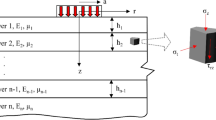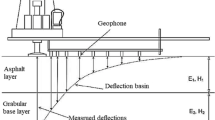Abstract
Nowadays, Finite Element Method (FEM) is used to predict pavement responses, which presents accurate results, considering all determinative parameters, including dynamic loading, crack, non-linear elastic and viscoelastic behaviours, damping and etc. On the other hand, due to the type of loads and the material properties, pavement analysis requires a lot of time. This paper describes the use of Artificial Neural Networks (ANNs) as pavement structural analysis tools for the rapid and accurate prediction of longitudinal strains at the bottom of asphalt layer of flexible pavements subjected to moving loads. A back propagation neural network of three layers is employed. Results indicate that ANN predicts the pavement strain with high accuracy. It is also demonstrated that ANN is an excellent method that can reduce time consumed and can be used as an important tool in evaluating the pavement responses.
Similar content being viewed by others
References
Abo-Hashema, M. (2009). “Artificial neural network approach for overlay design of flexible pavements.” The International Arab Journal of Information Technology, IAJIT, Vol. 6, No. 2, pp. 204–212.
Alsugair, A. M. and Al-Qudrah, A. A. (1998). “Artificial neural network approach for pavement maintenance.” Journal of Computing in Civil Engineering, ASCE, Vol. 12, No. 4, pp. 249–55, DOI: http://dx.doi.org/10.1061/(ASCE)0887-3801(1998)12:4(249).
Al-Qadi, I., Yoo, P. J., and Elseifi, M. A. (2008). “Dynamic analysis and in situ validation of perpetual pavement response to vehicular loading.” Transportation Research Board, TRB, pp. 29–39, DOI: 10.3141/2087-04.
Bayat, A. and Knight, M. (2010). “Investigation of flexible pavement structural response for the Centre for Pavement and Transportation Technology (CPATT) test road.” Transportation Research Board 89th Annual Meeting, Washington, D.C., USA, pp. 1–18.
Beskou, N. D. and Theodorakopoulos, D. D. (2011). “Dynamic effects of moving loads on road pavements: A review.” Soil Dynamics and Earthquake Engineering, Elsevier, Vol. 31, No. 5, pp. 547–567, DOI: 10.1016/j.soildyn.2010.11.002.
Booker, J. R. and Small, J. C. (1982). “Finite layer analysis of consolidation I.” International Journal for Numerical And Analytical Methods In Geomechanics, John Wiley & Sons, Vol. 6, No. 2, pp. 151–171, DOI: 10.1002/nag.1610060204.
Cebon, D. (1999). “Handbook of vehicle road interaction.” Swets & Zeitlinger Publishers, The Netherlands.
Ceylan, H., Tutumluer, E., and Barenberg, E. J. (1999). “Artificial neural network analyses of concrete airfield pavements serving the boeing B-777 aircraft.” 78th Annual Meeting of the Transportation Research Board, TRB, Washington, D.C., USA, pp. 110–117.
Dai, S. T., Van Deusen, D., Beer, M., and Rettner, I. (1997). “Investigation of flexible pavement response to truck speed and FWD load through instrumented pavements.” Eighth International Conference on Asphalt Pavements, Transportation Research Board, Seattle, Washington, USA, pp. 141–160.
Du, K. L. and Swamy, M. N. S. (2006). Neural networks in a softcomputing framework, Center for Signal Processing and Communications, Department of Electrical and Computer Engineering, Concordia University, Montreal, Quebec.
Duan, Z. H. and Poon, C. S. (2013). “Prediction of compressive strength of recycled aggregate concrete using artificial neural network.” Construction and Building Materials, Elsevier, Vol. 40, DOI: 10.1016/j.conbuildmat.2012.04.063.
Gillespie, T. D., Karamihas, S. M., Sayers, M. W., Nasim, M. A., Hansen, W., and Ehsan, N. (1993). Effects of heavy-vehicle characteristics on pavement response and performance, NCHRP Report 353, National Research Council, Washington D.C.
Gopalakrishnan, K., Thompson, M. R., and Manik, A. (2006). “Rapid finite-element based airport pavement moduli solutions using neural networks.” International Journal of Computational Intelligence, Vol. 3, No. 1, pp. 63–71.
Hadi, M. N. S. and Bodhinayake, B. C. (2003). “Non-linear finite element analysis of flexible pavements.” Advances in Engineering Software, Elsevier, Vol. 34, No. 11–12, pp. 657–662, DOI: 10.1016/S0965-9978(03)00109-1.
Huang, S., Hsu, C., Lee, C., and Chang, C. (2005). “Application of neural network for selection of airport rigid pavement maintenance strategy.” Journal of Marine Science and Technology, Springer, Vol. 13, No. 2, pp. 125–132.
Ioannides, A. M., Alexander, D. R., Hammons, M. I., and Davis, C. M. (1996). Application of artificial neural networks to concrete pavement joint evaluation, Transportation Research Record No. 1540, TRB, National Research Council, pp. 56–64, DOI: 10.3141/1540-08.
Khazanovich, L. and Roesler, J. (1997). DIPLOBACK: Neural-networkbased backcalculation program for composite pavements, Transportation Research Record No. 1570, TRB, National Research Council, Washington, D.C., pp. 143–150.
Meier, R. W., Alexander, D. R., and Freeman, R. B. (1997). Using artificial neural networks as a forward approach to backcalculation, Transportation Research Record 1570, TRB, National Research Council, Washington, D.C., pp. 126–133, DOI: 10.3141/1570-15.
Meier, R. W. and Rix, G. J. (1995). Backcalculation of flexible pavement moduli from dynamic deflection basins using artificial neural networks, Transportation Research Record No.1473, TRB, National Research Council, Washington, D.C., pp. 72–81.
Owusu-Ababia, S. (1998). “Effect of neural network topology on flexible pavement cracking prediction.” Computer-Aided Civil and Infrastructure Engineering, John Wiley & Sons, Vol. 13, No. 5, pp. 349–355, DOI: 10.1111/0885-9507.00113.
Ozan, E. (2011). “Artificial neural network based modeling of the marshall stability of asphalt concrete.” Expert System with Applications, Elsevier, Vol. 38, No. 5, pp. 6025–6030, DOI: 10.1016/j.eswa.2010.11.018.
Ozawa, Y., Maina, J., and Matsui, K. (2009). “Linear elastic analysis of pavement structure loaded over rectangular area.” Transportation Research Board 88th Annual Meeting, CD-ROM, TRB, Washington, D.C., USA, pp. 1–17.
Pidwerbesky, B., Steven, B., and DePont, J. (1997). “Dynamic loading effects on flexible pavement performance.” Eighth International Conference on Asphalt Pavements, Seattle, Washington, D.C., USA, pp. 117–128.
Pradeep, M., Ritter, M., Marzougui, D., and Brown, D. (2009). “Modeling, testing, and validation of the 2007 Chevy Silverado finite element model.” Transportation Research Board 89th Annual Meeting, CDROM, TRB, Washington, D.C., USA, pp. 1–18.
Saad, B., Mitri, H., and Poorooshasb, H. (2005). “Three-dimensional dynamic analysis of flexible conventional pavement foundation.” Journal of Transportation Engineering, ASCE, Vol. 131. No. 6, pp. 460–469, DOI: http://dx.doi.org/10.1061/(ASCE)0733-947X(2005)131:6(460).
Saffarzadeh, M. and Heidarpanah, A. (2009). “Effect of asphalt on the marshall stability of asphalt concrete using artificial neural network.” Scientia Iranica, Vol. 16, No. 1, pp. 98–105.
Sebaaly, P. E., Tabatabaie, N., Kulakowaski, B. T., and Scullion, T. (1993). Instrumentation for flexible pavements-field performance of selected sensors, final report, Vols. sbI and II, FHWA, Report No. FHWA-RD-91-094.
Sharma, N., Chaudhry, K. K., and Chalapati Rao, C. V. (2005). “Vehicular pollution modeling using artificial neural network technique: A review.” Journal of scientific & industrial research, CSIR, Vol. 64, No. 9, pp. 637–647.
Tapkin, S., Cevik, A., and Usar, U. (2011). “Prediction of marshall test result for polypropylene modified dense bituminous mixtures using neural network.” Expert System with Applications, Vol. 37, No. 6, pp. 4660–4670, DOI: 10.1016/j.eswa.2009.12.042.
Uddin, W., Zhang, D., and Fernandez, F. (1994). Finite element simulation of pavement discontinuities and dynamic load response, Transportation Research Record 1448, Washington, D.C., USA, pp. 100–106.
Uysal, M. and Tanyildizi, H. (2012). “Estimation of compressive strength of self compacting concrete containing polypropylene fiber and mineral additives exposed to high temperature using articial neural network.” Construction and Building Materials, Vol. 27, No. 1, pp. 404–414, DOI: 10.1016/j.conbuildmat.2011.07.028.
Wang, G., Roque, R., and Morian, D. (2011). “Evaluate near-surface stress states in AC Pavement based on 3-D tire-pavement contact model.” Transportation Research Board 90th Annual Meeting, CDROM, TRB, Washington, D.C., USA, pp. 1–17.
Xiao, F. and Amirkhanian, S. N. (2002). “Investigation of effects of asphalt binders on resilient modulus of rubberized mixtures containing RAP using artificial neural network approach.” Journal of Testing and Evaluation, ASTM, Vol. 37, No. 2, pp. 1–36, DOI: 10.1520/JTE101834.
Yabin, X., Yunmei, S., and Xuhong, L. (2011). “Network behavior perception based on improved BP ANN.” SciVerse ScienceDirect, Energy Procedia, Vol. 13, No. 124, pp. 124–130, DOI: 10.1016/j.egypro.2011.11.021.
Yoo, P. J. and Al-Qadi, I. L. (2008). “The truth and myth of fatigue cracking potential in hot-mix asphalt: Numerical analysis and validation.” Journal of Association of Asphalt Paving Technologists, Association of Asphalt Paving Technologists, Vol. 77, pp. 549–590.
Yoo, P. J., Al-Qadi, I., Elseifi, M. A., and Janajreh, I. (2006). “Effect of moving wheel load amplitude and interface condition on flexible pavement responses.” Transportation Research Board 85th Annual Meeting, CD-ROM, Washington, D.C., USA, pp. 1–16.
Zaghloul, S. M. and White, T. D. (1993). Use of a three-dimensional dynamic finite element program for analysis of flexible pavement, Transportation Research Record 1388, TRB, National Research Council, Washington, D.C., USA, pp. 60–69.
Zeghal, M. (2008). “Modeling the creep compliance of asphalt concrete using the artificial neural network technique.” Annual Congress of Geo-Institute of ASCE, New Orleans, Louisiana, USA, pp. 910–916.
Zelelew, H. and Papagiannakis, T. (2009). “Analysis of truck dynamic axle loads using hilbert huang transform.” Transportation Research Board 89th Annual Meeting, CD-ROM, TRB, Washington, D.C., USA, pp. 1–23.
Zhang, Y. and Zhang, X. (2011). “Dynamic response analysis of pavement and subgrade of highway.” IEEE Multimedia Technology (ICMT), International Conference on Hangzhou, pp. 1034–1036.
Author information
Authors and Affiliations
Corresponding author
Rights and permissions
About this article
Cite this article
Shafabakhsh, G., Talebsafa, M., Motamedi, M. et al. Analytical evaluation of load movement on flexible pavement and selection of optimum neural network algorithm. KSCE J Civ Eng 19, 1738–1746 (2015). https://doi.org/10.1007/s12205-014-0585-0
Received:
Revised:
Accepted:
Published:
Issue Date:
DOI: https://doi.org/10.1007/s12205-014-0585-0




